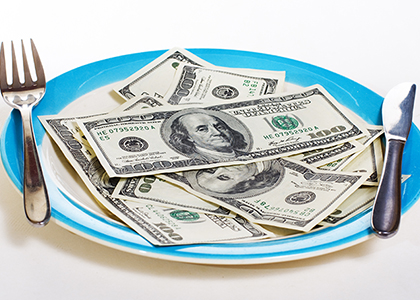
Cauliflower vs. Cookies: What’s Cheaper?
By Stacy Kennedy, MPH, RD, CSO, LDN; Reboot Nutritionist
“Eating healthy is too expensive” remains a common barrier to meeting wellness goals and consuming a diet rich in plant-based foods as suggested by the most recent Dietary Guidelines for Americans. Have prices for produce trended upwards while snack foods have gotten less costly? The answer may not be as simple as we think. It depends on the item; some have risen while others have fallen.
Overall, according to the USDA, prices for commonly consumed fruits and veggies that have remained a year-round staple since the 1980’s have actually declined, comparable with desserts and snack foods drop in prices. However, coming up with accurate estimates of cost is more complex than it may seem. When we include out of season and more convenient options, like pre-washed or pre-cut produce, costs are much more variable. The Consumer Price Index or CPI is used to compare prices for many types of foods and the USDA keeps tabs on food costs.
Produce That’s Getting Cheaper
What are these commonly consumed fruits and veggies that show better prices? These would include red delicious apples, bananas, iceberg lettuce, cabbage, carrots, celery, cucumbers, peppers, and dry beans (which, by the way is not actually a vegetable or fruit, but certainly a healthy plant-based food). The inflation-adjusted price for these items has fallen similarly to the fall of prices for chocolate chip cookies, soda, ice cream and potato chips.
Produce That’s Getting More Expensive
However, colorful, nutritious vegetables such as broccoli and field-grown tomatoes for example, have risen in price, in part because the majority are now purchased in convenient pre-cut, washed and bagged florets and growing methods for tomatoes have gone through updates in technology (that’s a discussion for other blogs!!).
What You Should Know
Iceberg Lettuce is NOT the new Kale
In some regard, cauliflower is the new kale, hitting all-time popularity and appearing as a transformed super star in recipes ranging from “pizza,” to “rice,” to mashed “potatoes,” Spicy “wings,” “poppers,” and of course classics like soup or simply roasted. Cauliflower is rich in cruciferous-based phytonutrients that support a healthy liver, has about 2 gm fiber and antioxidants like 51.6mg of vitamin C per cup. Iceberg lettuce on the other hand…lives up to its stereotype as a rather devoid source of nutrition with only 2 mg vitamin C and only 1 gm of fiber per cup.
The Key Issues with Price Discrepancy
While it’s true that all vegetables have not increased in price, the ones most popular in today’s culture and arguably more nutritious choices linked to reduced risk of disease, most certainly have seen a rise in cost, while no one can dispute that across the board, snacks and dessert prices have declined and are rather similar to 1980s costs.
Show Me the Money
This price inequity is certainly not helping make healthy eating any easier for our population where 70% are either overweight or obese and suffer from chronic, and in many cases, preventable illness. It’s no wonder that bananas and apples have remained the most commonly consumed fresh fruits among US consumers, since 1970. While health is important, affordability is essential for people to be able to actually execute the healthy eating behaviors recommended by experts.
An Apple a Day is Still Sound Advice
Apples contain loads of antioxidants and fiber for helping reduce cholesterol levels and risk of colon cancer. Bananas are certainly a nutritious option. Here are 5 reasons they’re better than you think.
Local Rules
The benefits of eating locally, shopping at Farmer’s markets and growing your own produce reach beyond nutrient levels and environmental benefits straight to your wallet. Now more than ever, consuming a variety of fruits and veggies over the year, based on seasonality, rather than enormous variety day-to-day, regardless of season, carbon footprint and other issues related to farm-to-table travel, is emerging as the best way to budget your food expenses and get the best nutritional bang for your buck. While it’s nice for many of us to have the privilege of being able to get any ingredient we want, whenever we want, does it really make sense to be buying fresh blueberries while we have 10 ft. of snow in New England in February? Probably not.
Read more on budget friendly juicing and cost savings with cooking.
What are your favorite cost savings tips for eating a plant-based diet?